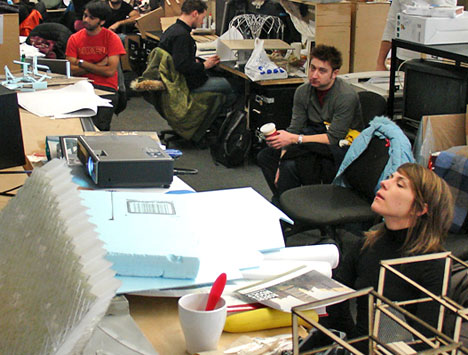








There's a torrent of talk in the news these days about 'sustainability.' And as design students, many of us spend a lot of time thinking about how to make our designs more energy efficient, healthier, and more environmentally sustainable. But amidst this onslaught of talk about sustainable design, one thing that doesn't often get mentioned is the sustainability of the atmosphere of design school.
I'm currently an architecture grad student, and despite my sincere passion for being in school, I can tell you that I've never seen a more unhealthy, more unsustainable environment than that of architecture school. How many people recognize this picture: students routinely spending 10-15 hours per day sitting in one place, glued to flickering computer screens working on 3D renderings, wedged into painfully cramped desks while toxic chemicals are mixed and handled all around them. I've often found myself in this exact position: eyes straining, back sore, trying to finish a project at 4am, under flickering fluorescent lights, while someone next to me melts acrylic with a cancer-causing chemical, the person on the other side of me hacking up toxic blue foam with a small saw, and the person behind me snoring in a sleeping bag underneath her desk. If you recognize yourself in this picture—consider this your wake-up call: THIS IS NOT HEALTHY!
Amidst this onslaught of talk about sustainable design, one thing that doesn't often get mentioned is the sustainability of the atmosphere of design school.
I frequently managed to pull multiple all-nighters in this type of environment, slowly watching more and more lines appear underneath my eyes and grey hairs popping up on my head. Why do we pay tens of thousands of dollars to subject ourselves to this kind of life, when other professional schools seem to have evolved to a more reasonable understanding of a live/work balance? Even medical schools, which used to be famous for torturing their students with grueling hours and unreasonable deadlines, have wised-up to the fact that red-eyed, sleep-deprived, pill-popping students can't learn effectively or make smart decisions. We do it because it's the culture of design school—this is what is expected of us, and what everyone around us seems to accept as 'the way things are.' This type of uber-competitive, insanely unhealthy atmosphere will only change when we decide to stop putting up with it, so the change has to start with you. And you can't fight the battle alone, so talk to your friends and teachers and try to get some support to stop the madness.
Here are 5 steps to taking back your life, and demanding a sustainable, healthy and productive experience as a design student:
A healthy lifestyle starts and ends with you. Learn how to stand up for yourself and don't succumb to the pressure of unhealthy attitudes around you. You are smart—you made it to design school—so you're smart enough to know deep down what is and what isn't good for you. Your teachers may pressure you, and your fellow students may compete to see who can go the most hours without sleep, so ignore them. Being a sheep won't get you anywhere in real life; none of the famous designers you admire are the type of people who are content to put up with the status quo. Look for support in your friends and in more enlightened faculty-members. It is only when enough people in design school realize that there is a better alternative that things will actually begin to change. Until then, hang in there and take responsibility for making the most out of your time in design school.
Jill is the founder of Inhabitat, as well as a freelance designer and architecture grad student at Columbia's Graduate School of Architecture and Urban Planning.